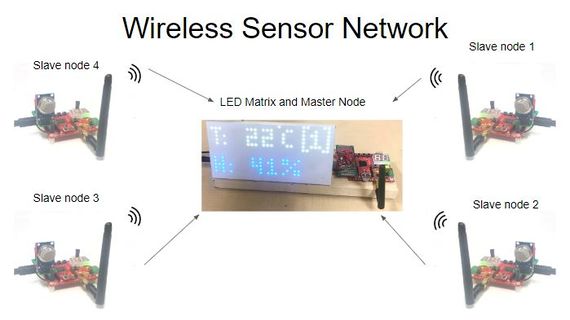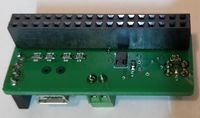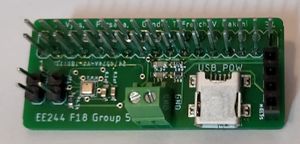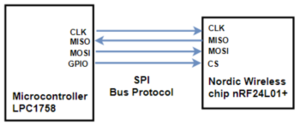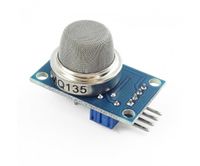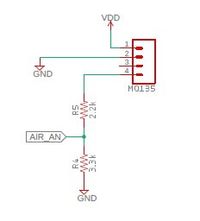F18: Wireless sensor network
Contents
Wireless Sensor Network
Abstract
A wireless sensor network (WSN) consists of collection of sensor nodes. Each individual node consists of MCU with on-board sensors and Nordic wireless mesh for communication, which are distributed to monitor physical or environmental conditions, such as temperature, ambient light, humidity etc. The SJ-One board contains an onboard light intensity sensor, and a custom PCB for the project has a combined Temperature, Pressure, and Humidity sensor and an air quality sensor. These sensor data are transmitted to a network coordinator which is the controls the wireless mesh network. The advantage of a mesh configuration is that the data flow is uninterrupted in the network even if one of the nodes fails. The coordinator board colates the data from all nodes, and displays it on a 16x32 LED matrix.
Objectives & Introduction
Show list of your objectives. This section includes the high level details of your project. You can write about the various sensors or peripherals you used to get your project completed.
Team Members & Responsibilities
- Halak Vyas
- Temperature, Pressure and Humidity Sensor Driver (BME280), RTC Config (primary), Wireless driver (secondary), .
- Jay Parsana
- Display driver (primary), Sensor drivers
- Prashant Gandhi
- PCB Assembly, PCB Design (review), Sensor drivers
- Tristan French
- Team lead, PCB Design (primary), PCB Assembly (secondary), Display driver (secondary)
- Vatsal Makani
- Wireless driver (Primary), PCB design (secondary), Wiki lead
Schedule
| Week# | Date | Task | Actual |
|---|---|---|---|
| 1 | 10/9 | Tristan
Everyone
|
Tristan
Everyone
|
| 2 | 10/16 | Everyone
|
Everyone
Unforeseen issues
|
| 3 | 10/23 | Vatsal
|
Vatsal
|
| 4 | 10/30 | Halak
Tristan
|
Halak
Tristan
|
| 5 | 11/6 | Halak
Jay
Prashant
Tristan
Vatsal
|
Halak
Jay
Prashant
Tristan
Vatsal
|
| 6 | 11/13 | Halak
Jay
Prashant
Tristan
Vatsal
|
Halak
Jay
Prashant
Tristan
Vatsal
|
| 7 | 11/20 | Halak
Jay
Prashant
Tristan
Vatsal
|
Halak
Jay
Prashant
Tristan
Vatsal
|
| 8 | 11/27 | Halak
Jay
Prashant
Tristan
Vatsal
|
Halak
Jay
Prashant
Tristan
Vatsal
|
| 9 | 12/4 | Halak
Jay
Prashant
Tristan
Vatsal
Everyone
|
Halak
Jay
Prashant
Tristan
Vatsal
Everyone
|
| 10 | 12/11 | Everyone
|
Everyone
|
| 11 | 12/19 | Everyone
|
Everyone
|
Parts List & Cost
Top level BoM
| Item# | Part | Source | Quantity | Unit
Cost($) |
Total
Cost($) |
|---|---|---|---|---|---|
| 1 | SJ One Board | Preet | 5 | 80.00 | 400.00 |
| 2 | Adafruit RGB LED Matrix | LED Matrix | 1 | 24.95 | 24.95 |
| 3 | LED matrix Connector board | LED Matrix | 1 | 1.00 | 1.00 |
| 4 | Led Matrix Power Adapter | N/A (Stock) | 1 | N/A | 0.00 |
| 5 | Air Quality Sensor | Willwin | 4 | 4.50 | 18.00 |
| 6 | Custom Sensor PCB Assembly | In House | 4 | 14.72 | 58.87 |
Total (minus SJ One cost): $102.82
Custom PCB BoM
| Item# | Part | Source | Quantity | Unit
Cost($) |
Total
Cost($) |
|---|---|---|---|---|---|
| 1 | Custom Sensor PCB | JLCPCB | 4 | 0.20 | 0.80 |
| 2 | SMD P, T, H sensor | Digikey | 1 | 6.628 | 6.628 |
| 3 | USB mini-B SMD receptacle | Digikey | 1 | 0.87 | 0.87 |
| 4 | 2-position screw terminal, .1in pitch | Digikey | 1 | 0.595 | 0.595 |
| 5 | 2-pin male header, .1in pitch | Digikey | 2 | 0.099 | 0.198 |
| 6 | 4-pin female header, .1in pitch | Digikey | 1 | 0.45 | 0.45 |
| 7 | 17-pin female header w/ long pins, .1in pitch | Digikey | 2 | 1.719 | 3.438 |
| 8 | Red SMD LED, 0603 | Digikey | 2 | N/A | 0.00 |
| 9 | 100 Ohm SMD resistor, 0603 | Digikey | 1 | 0.30 | 0.30 |
| 10 | 300 Ohm SMD resistor, 0603 | Digikey | 1 | 0.066 | 0.066 |
| 11 | 2.2 kOhm SMD resistor, 0603 | Digikey | 2 | 0.024 | 0.048 |
| 12 | 3.3 kOhm SMD resistor, 0603 | Digikey | 2 | 0.024 | 0.048 |
| 13 | 4.7 kOhm SMD resistor, 0603 | Digikey | 4 | 0.30 | 1.20 |
| 14 | 0.1uF ceramic capacitor, 0603 | Digikey | 2 | 0.038 | 0.076 |
| 15 | SMD Air Quality sensor | Digikey | 1 (optional) | 12.88 | 0.00 |
| 16 | 2-pin jumper, .1in pitch | Digikey | 1 (optional) | 0.45 | 0.00 |
Total: $14.72
Design & Implementation
The design section can go over your hardware and software design. Organize this section using sub-sections that go over your design and implementation.
Hardware Design
The project is based around the SJ one board, which uses an LPC1758 Arm Core M3 microcontroller. The system design consists of two main devices: a wireless master with a display and a wireless sensor node (of which there are several).
Hardware Interface
In this section, you can describe how your hardware communicates, such as which BUSes used. You can discuss your driver implementation here, such that the Software Design section is isolated to talk about high level workings rather than inner working of your project.
LED Matrix
Nordic Wireless
The Nordic nRF24L01+ wireless sensor is a highly integrated, ultra low power (ULP) 2Mbps RF transceiver IC for the 2.4GHz ISM (Industrial, Scientific and Medical) band. The nRF24L01+ is designed for operation in the frequency band of 2.400 - 2.483GHz. The high air data rate combined with two power saving modes make the nRF24L01+ very suitable for ultra-low power designs. This chip is interfaced with LPC1758 microcontroller of SJOne Board using SPI pins (MOSI, MISO, CLK, CS). It is the on-board chip in SJOne Board, so no breakout board connections are required for this project. We had to attach a RP-SMA Connector antenna to communicate between the multiple nodes and the master board.
Sensors
Light Sensor
Light Sensor is an on-board sensor in SJOne Board which interfaces with LPC1758 microcontroller at Port 0, pin 25 analog signal. This sensor shall give the raw value to the controller which will be processed by 12-bit microcontroller ADC. The output of the sensor is shown in a form of 'bulb' indication in LED Matrix
Temperature, Pressure & Humidity (BME280)
BME280 supports both SPI and I2C bus communication. In our wireless mesh project we have used I2C bus over SPI as I2C can read and write registers very easily in compare to SPI and Nordic Wireless is already using SPI bus.
Here we are using BME280 sensor of Bosch which has a facility to measure Temperature, Pressure and Humidity. It uses 3.6 microAmps of current at 1Hz and requires 3.3V of voltage which SJOne provides it.
Operating Range : Temperature (-40C to +85C), Pressure (300 to 1100hPa), Humidity (0% to 100%) with +- 1% of tolerance.
The sensor facilitates the user with various modes of operation which can be selected as per preferred environmental conditions. There are basically 3 modes for which range of IIR filter is varied. Those modes are - Indoor Navigation, Weather Monitoring and Gaming Mode. We have facility to switch between those modes, but here for our project we are using Indoor mode as our project is designed to test laboratory environment.
